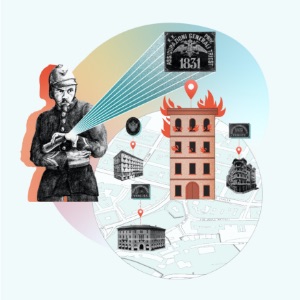Georg, the firefighter

Trieste, 6 June 1837
Dear Mother,
I am writing this letter to tell you that everything is going well here.
How are things in Vienna? How’s little Jole?
My health is good. The city welcomed me so well that I found a job within a few days. I am a firefighter! Don’t worry, it’s not a dangerous job. They gave me five days of training and now I can even handle the fire hose.
My colleagues come from all over Europe, there are: a German, a Greek, two Serbians, a Hungarian, and three Italians. We speak at least four different languages, and we use Triestine as a lingua franca.
We went out for the first time three nights ago. It was so exciting.
A strong bora wind had been blowing in Trieste for days, cooling the air and making the men’s hats and the women’s skirts fly.
At half past nine at night, the sky still clear, the alarm suddenly sounded; we climbed into the fire wagon, released the horses, and rushed in the direction of the fire.
It was dusk, an orange light covered the city, and the smoke was blown by the wind. We reached a stone building, near the Grand Canal, but we couldn’t see the fire; it must have started on the upper floors. I was scared. Thousands of questions swarmed around my head: what if I wasn’t up to the job? What if I got into some kind of trouble?
I certainly didn’t want to be like the wardens of the La Fenice theatre in Venice who slept while the theatre burned down!
In order to recognise the buildings that we have to protect, the policyholders put up “fire marks” bearing the inscription “Assicurazioni Generali” on the wall next to the entrance doors. That way, we know where we need to go, which buildings are ours.
But last night the plaque wasn’t where it was supposed to be; we went around the neighbourhood for what seemed like forever, and you have no idea how important it is to be prompt when there’s a fire involved.
There was a strong smell of smoke in the air, yet we couldn’t identify our building. Then, overcome by coughing from the smoke, I knelt down, and from that position saw the plaque. It lay on the ground, upside down, probably ripped off by the bora, or something else. I picked it up; it was hot.
I gave a sort of start, raised my head and saw the outline of the plaque standing out above the door in front of me against the background of the wall faded by the sun and salt.
“Es ist hier!” I shouted.
We dipped the pumps in the Grand Canal and started blasting water.
It took us the whole night to put out that fire.
We returned home exhausted but full of joy, joy that multiplied when the captain handed me that fire mark this morning, to thank me for finding it. “The company wants you to keep it,” he told me.
I can’t wait to show it to you, Mum. I do the best job in the world.
Oh, Mum, I’ve also made the acquaintance of a girl from here, whom I’ll gladly tell you about in my next letter and, who knows, perhaps one day I may show you her too.
Your son,
Georg
HISTORY
In 1831, the year Assicurazioni Generali was founded, fire insurance was quite widespread, as it was a very frequent category of damage. The fire mark system was simple and innovative: the metal plaques bearing the name and emblem of the company were displayed above the entrance of the insured houses to make the protected buildings easily recognisable.
The use of fire marks did not only benefit the owners of the insured properties, but also reduced the probability of flames spreading to uninsured neighbouring properties. This was thanks to the protection offered by the fire brigades also created at the instigation of the insurance companies, including Generali, which contributed to the establishment of regular bodies in various cities. This was a benefit for the safety and life of the whole community.
